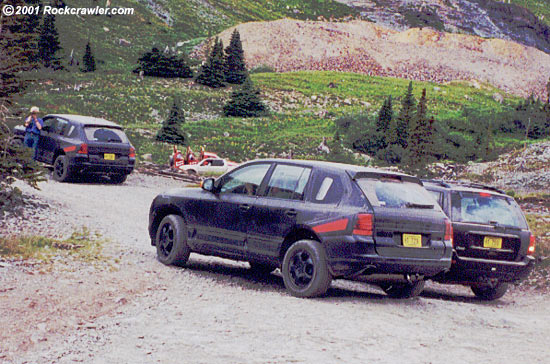Porsche used his latest development: the wheel hub motor, praised in the contemporary press as an "epoch-making innovation", to power his first all-wheel-drive automobile. Porsche's wheel hub motor functioned without gears and driveshafts because the wheel, which was connected directly to the rotor of the direct current motor, rotated around the stator which was attached to the wheel suspension. The drive mechanism therefore worked without friction losses to an extraordinary efficiency level of 85 percent. This Porsche invention was even employed by NASA when its moon car explored the surface of the moon. Today, international car manufacturers are using this technology for the development of future emission-free vehicles. Commercial vehicles also benefited from Porsche's all-wheel-drive technology. In 1912 he developed an eight ton tractor with a 100 HP six cylinder motor and a locking differential, which his client described as "a consummate machine!" It was also in 1912 that Ferdinand Porsche, who had been technical director of the Austrian Daimler Motor Company in Vienna since July 1906, began the development of the "Landwehr Train", based on an idea by and named after Ottokar Landwehr of Pragenau. It was a train that could run on the road as well as on track and was equipped with a "mixed petrol-electric" hybrid drive. These trains consisted of a generator car and a variable number of trailers, up to five on the road and up to ten on the track, each carrying a five ton payload. For rail journeys, flanged steel disks were screwed onto the solid-rubber-tired road wheels. A 100 HP petrol engine in the generator car was coupled directly to a 70 kilowatt dynamo. This supplied electrical energy via cables from the first to the last car to electric motors that drove every second axle of the train - similar to the present-day ICE 3. The multi-axle-drive killed two birds with one stone. On the one hand it could be operated with low axle weight of less than five tons, on the other it had a hill-climbing ability of up to 90 per mil, which had never been achieved on the road before, let alone on rail. These qualities were of particular importance because the "Landwehr-Train" was meant to transport the heaviest loads on dirt roads and even on provisionally laid field railways. The design of an NSU small car, which one could call the forerunner of the Volkswagen and which was planned as an all-wheel-drive model, originates from the early days of the Porsche Construction Office in Stuttgart's Kronen Strasse. In one drawing which the chief designer, Karl Rabe, made in 1934, a drive shaft leads from the motor in the rear to the front axle differential, which is very similar to the latter day Porsche all-wheel-drive concept of the legendary 959 through to the 911 Carrera 4 and the 911 Turbo. On-off front-wheel-drive was fitted to the Volkswagen Beetle type 87 of 1940 and the "Schwimmwagen" (floating car) type 166 of 1941, which was actually superior to much more powerful cross-country vehicles. Not all-wheel-drive, but four-wheel-drive distinguished the Mercedes world record beating T 80, constructed by Ferdinand Porsche in 1937. The two rear axles of the triple axle bolide with a sensational air resistance coefficient of cw = 0,18 were driven by a 3000 HP motor. The outbreak of war prevented its further utilisation. In 1947 the Porsche team, which had been evacuated to Kärnten in Austria during the war, developed a racing car with a centrally located engine, an on-off front-wheel-drive and a supercharged 1,5 litre, twelve cylinder compressor motor in the form of the "Cisitalia". Among other things, it was meant to have broken Bernd Rosemeyer's land speed world record over one kilometre, but it never reached the track due to financial difficulties encountered by the client, Piero Dusio. Of course, in this case the all-wheel-drive was not designed for cross-country capability but to convey the 385 HP as slip-free as possible to the road. The engineers went back to the understructure and motor of the Porsche 356 in their development of the "Jagdwagen" type 597 in 1955, which was also fitted with an on-off front-wheel-drive and was rated one of the best cross-country cars ever built up to that time. In the following years Porsche also worked on all-wheel-drive projects for several external clients. The first Porsche 911 with all-wheel-drive was the Cabriolet prototype exhibited at the IAA in Frankfurt in September 1981. Two years later it was the sensational Porsche 959 with its electronically controlled all-wheel-drive and complex understructure technology that adapted to driving conditions by regulating ground clearance and shock absorption. In 1985 the 959 won the Pharaoh Rally in Egypt, and in 1986 the extremely difficult Paris-Dakar Rally. The all-wheel-drive 911 had already won the Dakar Rally in 1984, which previously had only been open to cross-country cars and motorcycles. In the case of the 959, the front axle was driven via a controlled longitudinal clutch from the rear axle. The upper limit of the front axle driving torque was controlled through the longitudinal clutch so that over selective levers different programmes were activated adjusting the power distribution according to road conditions. This technology gave the 959 the decisive advantage that led to its triumph in the hot desert sand. The experiences gained with the "technological forerunner" of the 959 ultimately led to the most successful all-wheel-drive sport cars ever built by Porsche: the 911 Carrera 4, the first version of which was introduced in the autumn of 1988. Here the driving torque is first directed from the gearbox to a longitudinal planetary differential. As long as the lock control is not activated, 31 percent of the torque is continuously apportioned to the front axle and 69 percent to the rear axle. The fine adjustment is effected through the lock regulator. The longitudinal clutch of the Porsche 959 serves as a longitudinal lock, and the rear axel differential lock also originates from the 959. Both are constructed as segment clutches and are electro-hydraulically controlled with extreme speed and precision. In 1994 new standards were again set by the 911 Carrera (993 series) with its synthesis of all-wheel-drive, automatic brake differential and dynamically operating differential locks. The present-day superlative of all-wheel-drive technology is represented by the Porsche 911 Turbo, whose front wheels apply, according to required traction, between 5 and 40 percent of the driving power to the road and whose Porsche Stability Management (PSM) plays an essential role in active safety: if the car goes off course in extreme driving situations, it is restabilised in fractions of a second by electronic interventions on individual wheels. The additional drive of the front axle which is achieved through a visco-segment clutch, prevents extreme thrust through the front wheels during fast cornering and provides a neutral curve and drive behaviour. Moreover, the dynamic driving safety mechanism is greatly enhanced by PSM because it recognises via sensors whether the vehicle is following the course intended by the driver. If the car goes off course in extreme driving situations it is restabilised in fractions of a second by electronically controlled, targeted brake interventions on individual wheels. If this is insufficient, the PSM activates the engine management to reduce driving power. The combination of intelligent all-wheel-drive, PSM and the perfect drive tuning control offers active safety in the Porsche 911 Turbo to a level that has never been achieved before. So far, the engineers in the Porsche Development Centre in Weissach just grin and say nothing when asked about the all-wheel-drive capabilities of their latest creation, the Cayenne. Until 2002 one may only speculate about its sensational technological details.
Rockcrawler.com makes no guarantees as to the accuracy of statements made within press releases and holds no responsibilty for typographical errors or erronious data.
| ||||
|
||||


